Wednesday, August 31, 2016
Ascend Global Travel Services Presentation
Ascend Global Travel Services Presentation
via https://www.youtube.com/channel/UCtEc-WTq7uPoVuEFP1FEY-Q
Seven simple rules for effective email communication and outreach
Communication is key to success in life. No matter your industry, field, career, day-to-day responsibilities, or duties, communication is integral to your success.
This is particularly true in SEO and link building, where communication is vital to educating clients, gaining buy-in, executing campaigns, securing links, and presenting results.
Email is the primary mode of communication in today's digital world. If you can't communicate well through email, you'll struggle.
Benefits of effective communication
- Establishes trust, sets project scope, and defines expectations.
- Conveys and emphasizes the correct information.
- Enables both parties to be understood.
- Identifies team obstacles and facilitates problem solving.
- Ensures client, team, and personal satisfaction.
Your ability to present yourself well, communicate ideas, and pitch is fundamental to success.
Let me be clear:
Knowledge, skill, and integrity are vital to any business. But being able to communicate well is crucial in all aspects of work.
Good communication increases value, instills trust, builds confidence, resolves issues, reveals obstacles, and facilitates virtually every piece of an SEO campaign and relationship with clients, supervisors, and team members.
Communication is doubly valuable in link building, which requires one-to-one communication with other site owners in order to secure links. You need to effectively communicate WHY it's in their (or their audiences') best interest to link.
Here are my rules for effective email communication (and outreach):
- Use templates for format.
- Know your audience.
- Lead with value.
- Be clear and concise.
- Active language wins.
- Send complete emails.
- Follow up.
What is the goal of your email? Every single element of your email (subject line, structure, word choice) should support that.
1) Templates: how to format emails
Everyone has received terrible mass-produced emails with a template containing zero customization.
If I receive one more “Dear Webmaster” email…
Despite this, I fervently believe in the value of templates. Templates lead to systems and processes, which lead to well-formatted emails that are easy to read and understand (not to mention produce).
My rule of thumb for whether or not I use a template is:
- Am I sending multiple emails to a similar audience?
- Will I send a similar email in the future?
- Is there an optimal way to structure the information to convey my message?
The secret to a good template is list segmentation. Your template should be customized to your audience, leaving enough room for variance as needed.
Unless I'm replying to a thread or sending a unique email, it's highly likely I'm using some form of template.
Even hand written emails follow a general format (AKA template). Think about the various emails you have to send every day. I bet there are a handful of general templates you follow, even if you're composing each email individually.
Here's an example of a template I use often:
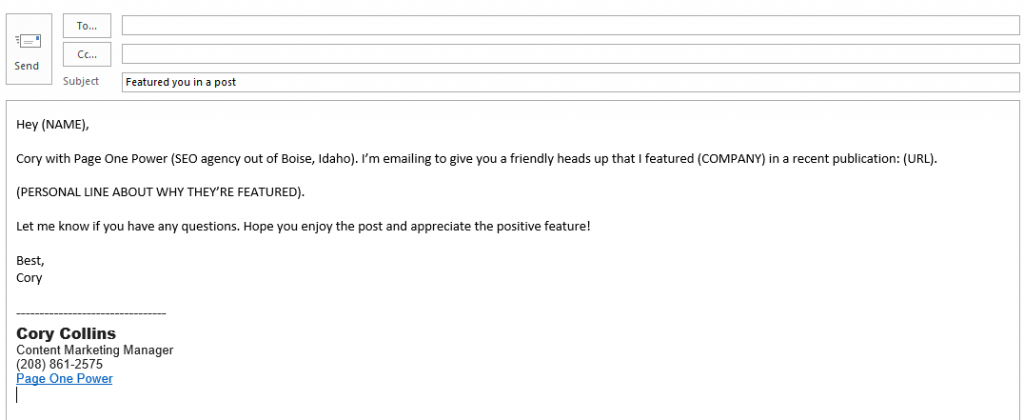
This is what I use when I include a positive mention of someone or their company in a post. This helps me build a connection, alerts them to the fact they've been mentioned and why, and maybe even nets me a couple social shares.
Creating processes is key to effectiveness. This idea of optimizing shouldn't be new to the SEO crowd
2) Know your audience
The most important rule of communication is to base the entire conversation around your audience.
Think about it:
How do you converse with a colleague? A supervisor? A client? A good friend? Your parent?
Style, tone, word choice, and mode of communication varies with each audience. It's communication 101 – you need to structure the conversation that makes sense and is effective for that audience.
Here's what you should know about your contact before drafting an email:
- Name
- Title/position
- Personality
- Authority/influence
- Their communication style
- How often they're pitched
- Your professional relationship.
If you send similar emails, regardless of audience, you're communicating ineffectively.
3) Value-first Communication
There's always a reason WHY you're sending an email.
To communicate effectively, it should be clear why you've sent an email, and why it matters to the person you're emailing.
It's the last bit – why your email matters to your contact – that's most important. Leading with this is how you establish value, and gain consideration.
You don't need to write a long introduction about who you are, or why what you're doing matters to the world. Lead with the value to your audience.
Why should they care?
The earlier you can answer this question in an email, the better.
When editing a template, my first step is always to move the “why this matters to you” statement to the top (or as near the top as possible).
Here's an email pitch I receive often:
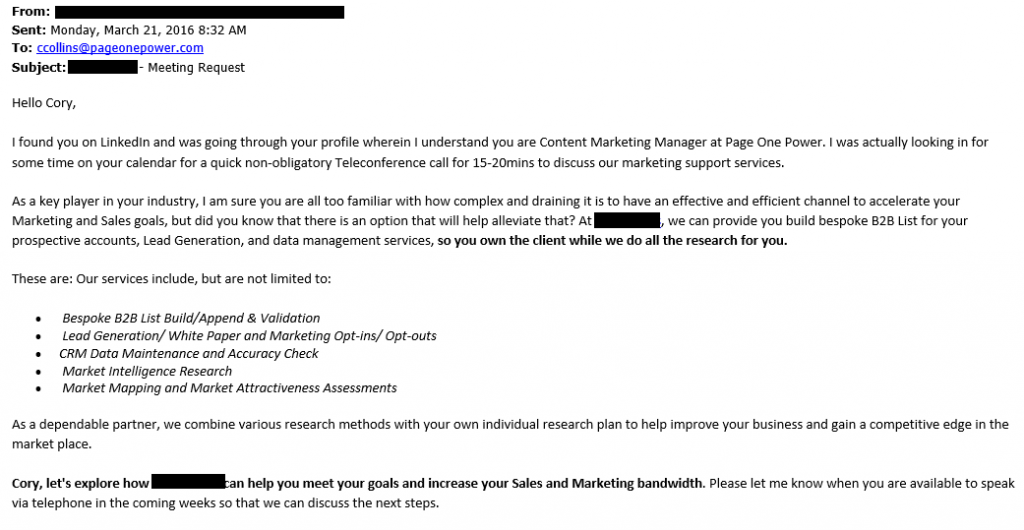
Here's how I would make this email value-first.
Hello Cory,
Are you working to improve your sales and marketing bandwidth?
(custom line that speaks directly to the person's position or the company).
At [redacted] we provide you with a bespoke B2B list for your prospective accounts, lead generation, and data management services, so you own the client while we do all the research.
We specialize in:
- White Paper lead generation.
- CRM Data Maintenance and accuracy.
- Market intelligence research.
- Market mapping and market assessment.
Let's discuss how [redacted] can help you meet your goals.
Is it perfect? No – this isn't my business so I can't rework the message or positioning. Also, I'm not looking to purchase or outsource list building, so I'm the wrong audience.
However, this reformatted version leads with value. It doesn't waste any time. If it's not the right fit, they can move on right away. If it is, they're more likely to actually read it and reply.
There should always be a reason WHY you're sending the email.
Don't bury your lede.
4) Clear and concise
The secret to good writing is liberal editing.
Write your email, then cut as much of it as you can. Then cut a little bit more.
I love to cut:
- Junk words: that, lot, thing, like, feels,
- Euphemisms: get the sense, to hear, to help, taking the time, let me know, look forward, the likes of, staying the course, etc.
- Adverbs: totally, specifically, fully, especially, etc.
- Improper pronouns: any unnecessary switching. Keep it first person as much as possible.
- Everything: if I can cut it, I will.
Don't obsessively reread emails before you send them. Instead, cut everything until you KNOW there's no junk left. Everyone will be happier for it.
5) Active voice is for humans
Active voice communicates the correct perspective and chain of events in email.
Email reports are especially reliant on active voice, as passive voice might misrepresent the work.
Passive language robs communication of cause and effect, making it unclear which action led to which result, and deemphasizes value in your email communication.
If you struggle with active versus passive voice, look for awkward phrasing and think about who did what. Make sure you're not obfuscating the information, for any reason.
A few examples of passive versus active:
“The page was optimized by the SEO.” vs “The SEO optimized the page.”
“Eight links were built by the team across the month.” vs “The team built eight links this month.”
“Rankings have improved and search traffic has been increased by our combined SEO efforts.” vs “Our SEO efforts improved rankings and increased search traffic.”
Passive voice will undermine your tone, confuse your meaning, and weaken your position.
6) Include your pitch
Don't pitch a request to pitch. Don't do it.
It happens often:
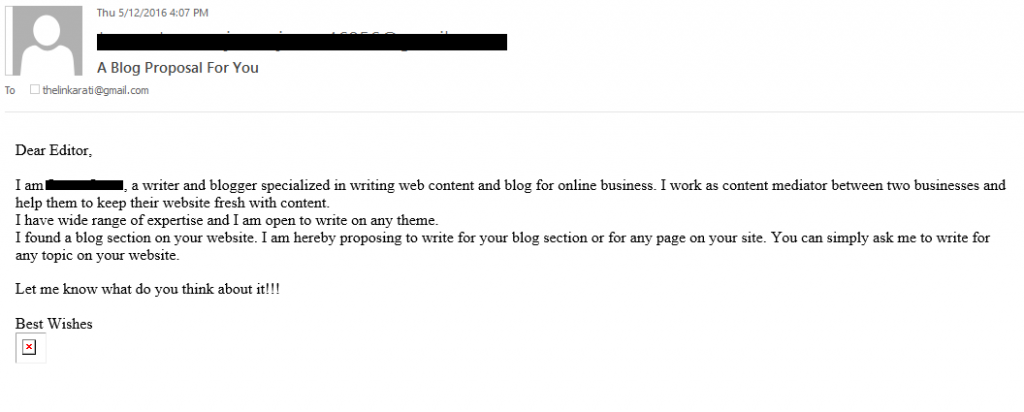
The best case scenario is a “yes, send along a pitch.” That same response might have been your ACTUAL goal – a link, a publication, coverage, meeting, etc.
Don't make life more difficult than it needs to be. Everyone is busy and everyone receives too many emails. Pseudo politeness isn't going to increase the odds your pitch will be successful, especially if you follow rule #2 and only send emails when you have value to add.
The best emails answer any question in the initial email. Consider your audience and make sure you cover everything within reason.
7) Follow up – It's polite
If you're building links or sending promotional emails, you're not doing your job if you don't follow up.
It's not rude to send follow up emails – it's polite.
The follow up email is a good litmus test for the value of your email.
If you believe you have something of value to offer, then you shouldn't be shy to send a reminder to ensure the person had a chance to review your email.
You're actually doing them a favor by making sure they didn't miss a reasonable opportunity. If you don't feel this way, you haven't refined your approach enough. You need to believe in the value of your message, the brevity of the outreach, the goals of your contact.
The upper limit I'll send is four. The original, with three threaded messages.
This isn't for contacts I have a clearly defined relationship with – only when I think someone truly is missing my emails and I have a valuable reason to be contacting them.
I can't tell you how many times I've had my third (or even fourth) email get a positive response. People are BUSY.
If you're not following up with your initial email at all, you're missing huge opportunity.
Tuesday, August 30, 2016
Five very quick tips to building a loyal ecommerce customer base
A few weeks ago, we discussed how ecommerce and retail companies can best acquire new customers via Facebook Lookalike targeting. So now that you're building your customer base, let's study how best to keep that very valuable base engaged.
Remember, your existing customers are a constant stream of revenue. We know they already like your products; now we want to make sure we continue to showcase new products and sales and in general stay top of mind with them.
This creates loyal customers and tons of repeat revenue – without that first layer of acquisition costs.
The balance can be tricky, though; how do you re-engage your customers without bombarding them with the same ads and messaging? How do you give them space but also encourage them to return to your site?
There are a few main things to keep in mind when setting up your re-engagement efforts:
Choose your platforms
Given we know who our customers are, I recommend using Facebook custom audiences (on both Facebook and Instagram) and Google's customer match targeting options (Gmail Sponsored Promotions and RLSA are those I would most highly recommend).

Use data to determine your re-engagement intervals
To calculate how often you should show your ads to customers, determine when they tend to come back to your site after purchasing. Do you typically see purchases made 15 days after the first purchase? 30 days later? Longer? This is when you should begin re-engaging with your customers.
Focus on creative
We want to make sure we are providing the user with a good reason to come back to our site. You'll want to showcase your products and ensure you are not showing the same ad over and over again. Refresh creative consistently to show new product as well as top sellers.
Use sales and promotions
Always hit your customers when you have a sale going on. This is typically the most successful of re-engagement efforts. Loyalty rewards programs are great for this, too; since you're not spending to acquire these customers, you should have a bit of margin to play with for loyalty-based discounts and incentives.
Get smart with your first-party data
This part is important: we don't want to just hit our entire customer base and treat them as equal. We need to segment our customer list by identifiable characteristics.
For example – AOVs (do they purchase more expensive products or cheaper products?), Gender, Product categories or type, etc. By segmenting out our audience type, we can better tailor our creative and the product we show to our customers to better suit their needs/interest.
Smart segmentation allows us to truly speak to our customers with relevant and tailored messaging, products, and overall user experience, which helps with both CTRs and CVRs.
For example, let's say you are an ecommerce shop with a variety of different products – from expensive handbags to shoes to clothing. By segmenting out users who purchase expensive handbags, you can then re-engage them with creative around 'the newest/trendiest' handbag – or your annual handbag sale.
There are other benefits associated with your customer base, of course – notably mining characteristics of that base to create lookalike targeting in the pursuit of new customers. But I've seen all too many brands pay too little attention to the five steps outlined above.
Don't leave all that juicy revenue out there; get smart about re-engaging and watch your numbers climb.
Monday, August 29, 2016
Why do big US companies take mobile less seriously than Chinese companies?
If you want to know how seriously any public company takes mobile, then take a look at the annual/quarterly reports.
While top Chinese retailers, banks and internet companies are keen to share their mobile success with their investors, their US equivalents are often shy to reveal their numbers… especially the biggest US retailers.
While researching a series of in-depth m-commerce reports for ClickZ Intelligence, I needed to establish which of the world's biggest countries are really making headway with mobile. The results are worth sharing.
The methodology was simple
1) Use Forbes' Global 2000 as a guide.
2) Stick to US and Chinese companies (as they dominate the Forbes list).
3) Concentrate on consumer facing businesses where mobile isn't the core business, but should be a very significant sales channel, so retailers, restaurant chains, banks and internet companies are in; but mobile companies and oil companies and manufacturers are out.
4) Then check the latest annual (2015) and quarterly statements (Q1 and Q2 2016) to see which detailed mobile performance – only hard numbers; PR fluff was ignored.
The results were striking:
- The top Chinese banks, retailers and internet companies all (of those considered) detail mobile performance, often in considerable depth.
- Three out of four top US banks declare mobile numbers. But not in as much detail as the top four Chinese banks.
- Of the two US internet giants, only one details mobile performance: Facebook. Alphabet (Google), surprisingly, doesn't.
- Not one of the Top 10 US retailers from Wal-Mart to Amazon.com, shared mobile stats in their recent annual or quarterly report.
The US retailers were a big shock – especially Amazon. In 2016, you have to ask: why we couldn't find any indication of mobile performance in financial reports of the US top retailers?
And, more importantly, you have to ask: why aren't investors and analysts asking the same thing?
The more financial reports you look at the more you come to the conclusion: Chinese companies – and their investors – take mobile more seriously.
They saw the mobile opportunity earlier; they made it a priority to re-engineer their companies to take full advantage; and now they want investors to benchmark them on their impressive mobile performance.
Alibaba: the benchmark in mobile performance and reporting
This month the Chinese ecommerce retail market place Alibaba redefined what it means to be “mobile first” announcing that it has 427 million mobile monthly active users (MAU) – out of a total of Alibaba's 434 million total users.
In the latest quarter (Q2, 2016), mobile accounted for a stunning 75% of value of all goods bought and sold on the platform and 75% of its revenues.
Just to put Alibaba's 427 million mobile users into perspective:
- The entire population of the US is 324 million.
- Walmart's global customer base 260 million (Note: Walmart measures weekly shoppers; Alibaba's are monthly).
The wake-up call for all companies is twofold
- A mobile-first strategy delivers tangible rewards.
- How well the markets received the news…
Financial investors and analysts loved Alibaba's results. On announcement of the Q2 results, the stock leaped to its highest level for 18 months.
This is the carrot: impressive mobile performance is increasingly a factor (one of several) that encourages investors to purchase stock.
The question is: when will US investors / analyst start to use the stick to punish (US) companies that keep their mobile numbers a secret?
US investors are becoming well acquainted with, and increasingly attracted to the Chinese retail and internet companies such as Alibaba, JD.com, Baidu and Tencent (all of which detail impressive mobile performance in their financial reports; all of which saw their share price improve on the latest results.
Three out of four are quoted on US markets: Alibaba is listed on the NYSE; JD.com and Baidu on Nasdaq (Tencent is listed on HKSE), which means they'll remain front of mind.
For share price performance, see: BABA; JD; BIDU; and 0700.HK (Tencent).
Stick and carrot – Facebook's mobile story
Any US company that doesn't believe how seriously US investors take mobile needs to look at Facebook's recent financial history.
One of the main reasons Facebook's share price went into freefall post its 2012 IPO was that investors were very unimpressed with its mobile story. One of the main reasons they love it now is because they are impressed with its mobile numbers.
As recounted by Fortune in 2015:
Facebook used its weakness on mobile as a motivator. When the company went public it had no meaningful revenue from mobile. Within 18 months, Facebook delivered a magnificent about-face on mobile, quieting the haters in the process. By the end of 2013, more than half of Facebook's revenue came from mobile ads. “You want mobile revenue? We'll show you mobile revenue!” the company seemed to say. Wall Street rewarded the company by trading up its stock.
Today Facebook wants to be measured on its mobile record. In its Q2 2016 results statement it couldn't shout louder about its mobile success:
Second Quarter 2016 Operational Highlights
- Daily active users (DAUs) – DAUs were 1.13 billion on average for June 2016, an increase of 17% year-over-year.
- Mobile DAUs – Mobile DAUs were 1.03 billion on average for June 2016, an increase of 22% year-over-year.
Second Quarter 2016 Other Financial Highlights
- Mobile advertising revenue – Mobile advertising revenue represented approximately 84% of advertising revenue for the second quarter of 2016, up from approximately 76% of advertising revenue in the second quarter of 2015.
The phenomenal rise of Facebook's stock price, see FB, from mid-2013 tells you everything you need to know about investor attitude to mobile.
How the largest companies rack up on mobile transparency
By way of research we looked at the recent annual and/or quarterly reports and earning statements of relevant companies from the world's biggest public companies according to Forbes, which is dominated by Chinese and US companies, to see to what extent (if at all) mobile performance is displayed.
The Forbes rankings are based on a mix of revenue, profits, assets and market value.
Chinese banks:
Three Chinese banks occupy the top three Forbes rankings, with a fourth in sixth ranking. All four appear to have made mobile banking a priority over recent years and the numbers are staggering. At the end of 2015, they have 590 million mobile banking customers between them. That's 1.8 times larger than the population of the United States.
- Industrial & Commercial Bank of China has 190 million mobile customers, with annual transaction volume of over RMB800 billion (US$121 billion), which is approximately 38% of its customer base. (Source 2015 Annual Report)
- China Construction Bank has 182.84 million (up by 25% year on year) mobile banking users, with a transaction volume was RMB15.4 trillion (US$2.3 trillion), which is approximately 54% of its customer base. (Source 2015 Annual Report)
- Agricultural Bank of China has 140 million mobile customers, with annual transaction volume of over RMB9.6 trillion (US$1.5 trillion), this is approximately 29.5% of customer base. (Source 2015 Annual Report)
- Bank of China has 79 million mobile customers, with annual transaction volume of over RMB5.2 billion (US$0.7 billion), the proportion of the customer base that is mobile is unclear. (Source 2015 Annual Report)
US banks:
Three of the top four US banks share mobile banking numbers. Although mobile customers are dwarfed by the vast numbers of their Chinese counterparts are a significant proportion of their total user base.
- JP Morgan Chase (Global Rank 5) has 24.8 million active mobile customers. As JPMC only counts its customer base by households (59.2 million), rather than individuals, it is unclear what proportion of customer are mobile. Mobile transaction value is unavailable. (Source Q2 2016 results).
- Wells Fargo (Global Rank 7) has 18 million mobile active users. This is approximately 25.7% of customer base. Mobile transaction value is unavailable. (Source Q2 2016 results)
- Bank of America (Global Rank 11) has 20.2 million active mobile banking customers in Q2 2016. It is unclear what proportion this is of the total customer base. But it does reveal in its investor presentation that mobile equates to 17% of total deposit, and on a weekly basis it is the most active channel. See charts below. (Source Q2 2016 results)
- Citigroup (Global Rank 13). We were unable to find mobile numbers for Citigroup, but the company did state in its 2015 Annual Report that it is implementing a “mobile first” approach via a newly established Citi FinTech unit.
Brian Moynihan Chairman and CEO, Bank of America explains to shareholders why mobile banking is so important:
Why are we tripling our investment in 2016? It is simply because this is how customers want to do business with us. Our customers deposit 250,000 checks a day through their mobile devices, reflecting 15 percent of consumer deposit transactions. We would need an additional 650 financial centers to handle the deposit activity that is currently being done on those mobile devices.
Chinese retailers:
China's highest ranking retailers on Forbes list are Alibaba (rank 174) and JD.com (rank 800). Despite their lowly ranks, compare to US companies such as Walmart (rank 15), these are no small fry.
- Alibaba is an internet marketplace where third-party retailers sold RMB 837 billion (US$ 126 billion) of goods in Q2, 2016. (That's six times the value of goods sold on eBay in the same quarter). As noted above, 75% of this GMV and 75% of the revenue it makes from these sales. Total revenue is RMB 32.2 billion (US$ 4.8 billion), which means Alibaba's revenue from mobile is
Most interesting is the news that Alibaba now makes more money from each of its 427 million mobile user than from non-mobile customers. (Source Q2, 2016 results)
- JD.com is a direct ecommerce retailer and internet marketplace, it makes more in revenue than Alibaba, at RMB 65.2 billion (US$9.8 billion), in Q2, 2016, hence its claim to be “China's largest ecommerce site by revenue”. But GMV (value of total goods sold) is lower than Alibaba at RMB160.4 billion (US$ 24.1 billion), though still slightly above eBay.
Unlike its rival, JD does not reveal what proportion of revenue or GMV is mobile or the number of mobile users. But it does declare that an impressive 79% of its orders placed on mobile. (Source: Q2, 2016 results)
Like its rival Alibaba, JD's earnings were well received by investors.
US retailers:
Compared with the mobile details (and outstanding mobile performance) shared by the Chinese retailers, the details shared by US retailers is disappointing.
Searching through the 2015 annual report and quarterly earnings statements (up to August 18 2016), we were unable to find mobile performance numbers of any descriptions for the following US retailers and restaurants.
- Wal-Mart Stores (Forbes rank 15)
- CVS Health (rank 62) – no mobile numbers apparent in 2015 annual report, Q1 or Q2 2016 reports.
- Walgreens Boots Alliance (rank 107)
- Home Depot (rank 112)
- Target (rank 164)
- McDonald's (rank 189)
- Costco Wholesale (rank 192)
- Lowe's (rank 205)
- Kroger (rank 223)
- com (rank 237)
- The Priceline Group (rank 445)
- Macy's (rank 515)
There were two US retailers/restaurants sitting outside the top 10 that revealed some details of mobile performance:
- Starbucks (Forbes rank 389) reveals the adoption of mobile ordering and payment by customers. In Q3 2016 Mobile Order and Pay usage reached 5% of the coffee chain's U.S. transactions, up from 4% in Q2 FY16. (Source Q3, 2016 results)
- eBay (rank 466) does not include details of mobile performance in its actual earnings releases, but in an accompanying “Fast facts” document it declares that $9.5 billion of sales on the auction site were completed on mobile devices in Q2 2016. This means mobile sales volume is now 45.5% of the GMV for the quarter ($20.9 billion). eBay also states that 57% of sales are touched by mobile at some point. (Source eBay Fast Facts – PDF).
Chinese internet companies
There are two prominent internet companies in China, Tencent Holdings (Forbes rank 201) and the Baidu (rank 349):
- Tencent businesses include the QQ web/mobile portal, instant messaging and gaming platform, the Qzone social media site and the Weixin/WeChat social/chat smartphone application. As of June 2016, Mobile QQ has 667 million monthly active users (MAU) users, Qzone has 596 million MAU and Weixin/WeChat has 806 million MAU. Mobile's contribution to revenue is not available, except reporting that smartphone games delivered RMB 9.6 billion (US$ 1.4 billion) in revenue (Source Q2, 2016 results)
- Baidu is a mobile/web search engine, with portfolio of associated products. In its Q2 2016 results it reported it had 667 million mobile search MAU and 343 million mobile maps MAU. Total or online MAUs were not reported. Mobile revenue represented 62% of total revenues for the second quarter of 2016, compared to 50% for the corresponding period in 2015. This works out at RMB 11.3 billion (US$ 1.7 billion). (Source Q2, 2016 results)
US internet companies
The two prominent Internet companies in USA are Alphabet, the company formally known as Google, (rank 27) and Facebook (rank 188). The contrast is remarkable.
- Facebook now has over 1 billion (1.03 billion) mobile daily users (DAU), which is 91% of total DAU. Mobile advertising revenue accounts for 84% of total ad revenue (US$ 24 billion) which means Facebook earns US$ 5.24 billion in mobile ad revenues.
- Alphabet does not report mobile numbers in its 2015 annual report or 1Q or 2Q 2016 reports. It appears from the investor earnings calls that mobile is very important to Google, which makes it inexplicable that the company does keep investors informed of mobile performance. (Source Q2, 2016 results and earnings call)
Sundar Pichai, CEO Google, investor briefing Q2 2016:
“Q2 2016 earnings call: Our investment in mobile now underlines everything that we do today from search and YouTube to Android and advertising. Mobile is the engine that drives our present.”
Room for improvement
We look forward to the time when US companies feel confident enough about their mobile numbers to share them in their financial reports; or the time when investors start to insist on it.
N.B. This study was not an in-depth research project, it was based on observations from the companies' financial reports. If any of these retailers share numbers elsewhere / or would like to share their mobile numbers, please contact the author Andy Favell who will be very happy to update the ClickZ readers.
Read the reports:
- DNA of a Great M-Commerce Site Part 1: Planning
- DNA of a Great M-Commerce Site Part 2: The 12 Pillars of Mobile Design
This is Part 28 of the ClickZ 'DNA of mobile-friendly web' series. Here are the most recent chapters:
- Mobile menu UI: bold buttons and intuitive types of navigation
- Should the hamburger icon be on your mobile menu?
- M-commerce: has the mobile web finally won?
Andy Favell is ClickZ columnist on mobile. He is a London-based freelance mobile/digital consultant, journalist and web editor. Contact him via LinkedIn or Twitter at Andy_Favell.
Friday, August 26, 2016
Thursday, August 25, 2016
Why mobile commerce sites should be designed for context
If you want your m-commerce project to deliver the results you're expecting, context should be front and centre of your design.
Across all industries, mobile traffic is eating into PC web traffic in a big way, even in economies which have a large installed base of consumer PCs.
But ecommerce sites aren't seeing mobile web visitors, particularly those who use smartphones, converting to mobile shoppers with the same success as PC shoppers.
As Andy Favell writes in ClickZ Intelligence's new report, 'The DNA of a Great M-Commerce Site Part 2: The 12 Pillars of Mobile Design':
“It is fair to conclude that conversions would be higher if the m-commerce experience on the web was better designed with smartphone users in mind. M-commerce sites that crack this will sell more.”
One of the most consistent mistakes made with mobile site design is a failure to take into account the differing circumstances, needs and intentions of smartphone users; in other words, their unique context.
The difference between smartphone and PC users isn't just a smaller screen size – it's a whole new set of variables.
Google's guidelines for its search quality evaluators emphasise the importance of taking context into account for mobile users.
So how does context impact the way you cater for m-commerce customers, and what can you do to tailor your design to their needs?
Why design for context?
A customer using a PC to access your website is likely to be doing so in a limited number of settings. Most often they'll be at home or at work, possibly in an internet café, or using a laptop somewhere like an airport or coffee shop.
Even if you imagine that they might be out and about, there are still relatively few plausible scenarios in which they could be logging in, and they don't differ from one another that wildly.
But with mobile, and particularly smartphones, the number of possible scenarios suddenly increases exponentially. Your customer could be travelling, working, moving around the house and multi-tasking, walking to your location, walking to a rival's location…
In each case, the context drastically alters the way in which this customer might be approaching and interacting with your site.
Andy Favell explained in a recent article for ClickZ, 'When will responsive websites respond to user context?' why cross-platform homogeneity – taking the same approach to design across differing platforms – doesn't make sense.
“Cross platform homogeneity forgets two massive things:
- The requirements of the desktop and mobile user are often different
- The requirements of the same mobile user (more importantly) vary depending on whether they are at home, at work, commuting, on route to the location, on site, in a rival's location and so on.
And that's just the start of it. Now consider:
- How context varies by time of day, day of week, time of year.
- What about the trigger that causes the visit to the site e.g. something on TV, snapping QR code in a print ad, tapping through from an email, social media etc.?”
Taking a user's context into account is considered to be a no-brainer for targeted advertising, and the conversions it delivers prove that targeting works.
Facebook has achieved great success from advertising thanks to its ability to fine-tune its adverts according to who a user is and what they might be doing.
 Image by Bablu bit, available via CC BY-SA 4.0
Image by Bablu bit, available via CC BY-SA 4.0
Google is increasingly using the data it collects on users and their search histories to contextualise the results it provides them and make them more relevant. And programmatic advertising is currently making waves with the promise of being able to determine at high speed who to target based on digital cues received about the user.
The online world is increasingly trending towards high levels of personalisation as our ability to gather and interpret data about users improves. And for m-commerce, this also seems like the logical next step.
As Favell writes in 'The DNA of a Great M-Commerce Site Part 2':
“If adtech has the ability to target ads on mobile websites at visitors, surely m-commerce sites should use the same types of technology and listen to the same digital signals in order to prioritise the most appropriate content, offers and services, and make the user journey as easy and frictionless as possible?”
How to design for context in m-commerce
In part two of the 'DNA of a Great M-Commerce Site' report, Andy Favell gives a series of tips on how to personalise your mobile offering to users whilst not over-targeting to the point that users find it irritating. He advises:
- Prioritising content, rather than selecting which content to show to the exclusion of others
- Suggesting entries in search or form fields, such as postcode or ZIP code in a search box
- If your website defaults to departments based on previous behaviour – for example, ASOS will open the men's or women's store homepage based on what the user has browsed previously – make sure it is clear how to return to the general homepage
- Facilitating the buying process with options to save for later, save a favourite address, save a favourite meal
- Encouraging a trust relationship by explaining how personalisation works and how it benefits the user
- Making it easy to opt in or out of personalisation
The epitome of a personalised m-commerce experience is a site that adapts fully to user context, based on signals such as who a person is, where they are, what device they are using, what they like and what they are doing.
While there are very few examples of websites who are doing this well at the moment, the concept isn't too far-fetched.
A handful of retailers in the US have already invested in developing native apps which deliver a different experience to the user when they are away from a store versus when they are in-store.
The most innovative of these will switch to “Store mode” as the shopper enters a store location, activated by geotechnologies like bluetooth beacons.
A number of US retailers have personalised their m-commerce offerings with a dedicated “store mode”, which includes features such as scanning products to check pricing and availability | Image by Intel Free Press, available via CC BY-SA 2.0
DMI's 2015 'In-store Mobile Experiences' report sets out why a properly personalised in-store mobile experience can be so beneficial to retailers.
According to the report, 82% of high-income shoppers said that an improved mobile in-store experience would make the shopping experience better. And 74% of young people aged 18-35 said that they would spend more money at a store that provided an improved in-store mobile experience.
Standout performers in the US – which included Walgreens, Home Depot, Nordstrom, Walmart, Target and American Eagle among other brands – offered in-store features such as scanning products to unlock information on pricing and product availability; integrating loyalty programs into the in-store experience; in-store mapping; product recommendations; and reserving a dressing room.
These are all location-dependent personalisation features, but there are other mobile signals you can use to divine information about your user's context and tailor your m-commerce site to them in subtle ways.
In 'The DNA of a Great M-Commerce Site Part 2', Ronan Cremin, CTO of DeviceAtlas, writes:
“Apart from the really obvious one (location) there are other possibilities like detecting if a user is literally on the move or not (accelerometer), is the battery low etc. etc.
One important point about all of these contextual cues is to use them as hints rather than hard deciding factors because the cost of getting things wrong based on an incorrect assumption is high.
It's really dangerous to make assumptions about what a user wants, so I think that the best thing to do is make prioritization decisions over ordering of features rather than adding/removing features entirely.”
 Subtle cues about a user's state like battery level can be used to personalise your m-commerce site | Image by Martin Abegglen, available via CC BY-SA 2.0
Subtle cues about a user's state like battery level can be used to personalise your m-commerce site | Image by Martin Abegglen, available via CC BY-SA 2.0
As both Favell and Cremin point out, it's important not to go overboard with personalisation, as too much can risk alienating the user, especially if wrong assumptions are made.
But don't let this put you off trying altogether. Context is everything in mobile design, and even small adjustments can go a long way towards creating a frictionless user experience and improving your m-commerce sales and conversions.
You can read the full ClickZ Intelligence reports here:
- DNA of a Great M-Commerce Site Part 1: Planning
- DNA of a Great M-Commerce Site Part 2: The 12 Pillars of Mobile Design
This article has been adapted from a post originally published on our sister website ClickZ: Why context is king in m-commerce.
Tuesday, August 23, 2016
Voice UI and intelligent assistants: trends to watch out for next
Earlier this year, a report from Consumer Intelligence Research partners (CIRP) pegged the sales of Amazon's Echo at more than 3 million units.
Echo of course uses Amazon's cloud based AI “Alexa” to answer questions, play music/games, control smart devices including home automation systems and of course re-order products off Amazon.
More importantly, awareness of this device and others like it continues to accelerate.

In fact, according to CIRP, awareness of Echo more than doubled though the course of last year from 20% in March 2015 to more than 50% by year's end.
While an aggressive and memorable ad effort featuring Alec Baldwin, Dan Marino, and Missy Elliot may have contributed to Echo's increasing awareness and popularity, its value proposition, robust and growing functionality and perceived promise are ushering in a new era – the AI, Machine Learning and voice UI era.
Here are a few trends and predictions to look for as we prepare for this exciting wave which will most certainly become ever more present in our everyday lives and tasks.
Trends in intelligent assistants
Listening to Amazon's Charles Kindel at the Eniac M1 Summit confirms, Amazon has big plans for its cloud based omnipresent AI technology.
Those plans include how this intelligent assistant can be integrated into and can interact with other IOT devices and services be it your smart phone/watch/home, gaming/music systems and even cars, as is the case with Ford SYNC.
Clearly Amazon believes Echo and “Alexa” is so much more than just a product, it's a framework and platform that will be open to a growing number of outside developers.
Expect tens of thousands of developers to jump on the bandwagon in the coming years as they look to integrate Alexa into their own products as this technology moves quickly into the mainstream.
But don't be fooled, Amazon won't be alone and it's not the only game in town.
Both Apple with its Siri, Microsoft with its Cortana and Google with the Google Assistant and Google Home offering will compete aggressively here, particularly given their dominance on the mobile/smartphone OS front.
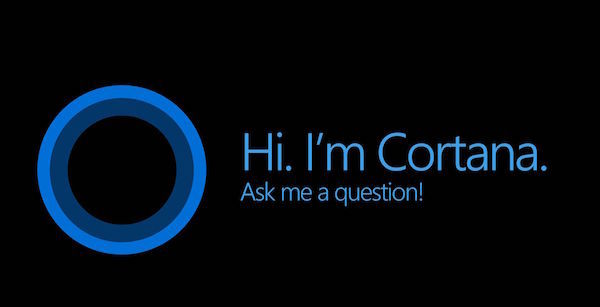
Given that advantage and footprint, it will be particularly interesting to see how Amazon will explore ways in which Alexa can be more deeply integrated into Apple, Google and Microsoft powered smartphones.
It should also not come as a big surprise if Amazon looks to both acquire and build solutions to support the continued adoption of its intelligent assistant Alexa.
The company's strong track record to continually experiment and innovate remains part of its culture. Bigger and bigger successes, such as AWS and Echo/Alexa, will only fuel bigger bets and experiments, and rest assured, Alexa-related investments and innovations are forthcoming.
Finally, because these voice UI's and intelligent assistants continually listen for key words and are collecting more and more info about its users to be helpful, privacy concerns have arisen.
Hopes and fears
While each company has assured users the data is not stored or shared, the always listening and learning capabilities can be unsettling.
Look for greater notice, data access and controls to be integrated into all solutions as our intelligent assistants become an increasing part of our lives.
We are on the threshold of a new era lead by AI, NL and machine learning and the emergence of the voice UI somewhat depicted in the Spike Jonze movie HER is yet another step closer to reality.
Friday, August 19, 2016
How to maximise PR outreach for site visibility in organic search
How can you earn those coveted links and mentions in news and media sites that generate an incredible influx in domain authority?
When combining SEO, PR, and content marketing, you create a winning formula for increased organic visibility, brand awareness, and social amplification.
In this article, we'll go through the steps required to create a cohesive strategy that integrates SEO and PR and maximizes the reach and outcome of both.
1. Research & ideation
When determining the content that will resonate most with editors, journalists, and consumers, make sure you research and have as much data as possible at your disposal:
- Who are your buyer personas?
- What are the different stages of the buying cycle for your particular products and services?
- Include psychographic research and data. What do they love? What are their pain points?
- What are the keywords that each of those buyer personas typing in at each state of the buying funnel?
- What keywords and articles are your competitors targeting to reach your target audience? With SEMrush, you can identify keywords your competitors are ranking for and traffic trends.
- What questions are your target consumers posting on sites like quora or forums related to your products or services?
- What content related to your industry is getting the most social amplification? Use Buzzsumo to search for related keywords, competitor contents, and set up alerts for your most relevant keywords
- What holidays, awareness months, or special days are relevant to your audience?
- What stories have broken that are relevant for your target audience? Trendjacking is a MUST when you are working with public relations teams.
Unless you've taken time to perform extensive research and have comprehensive data to work with, your entire amplification strategy may fail as it will not capture the interest of the journalists, bloggers, and influencers that you are trying to reach.
Segmenting audiences and crafting your editorial calendar to target each of these segments will increase the likelihood of earning media coverage.
2. Content creation
Once all of your research is completed, you have to wrap it all together into an editorial calendar. Your social, content, and press editorial calendar should be synced with each other.
If PR has identified a topic that is of interest to a journalist, this concept can be used by the content marketing team to create content for the blog, infographics, explainer videos, and social media posts. These visual assets can then be sent to the media using a press release and direct media outreach.
A 2012 study by PR Newswire found that press releases with photos garnered twice as many views as text alone. Infographics, data visualizations, live or animated videos, and reports or case studies are powerful assets used by PR teams which can be spearheaded and created by the SEO /Content Marketing team.
Whatever format you choose to use, avoid the one-and-done mentality. A survey can be used to create an infographic, which can then be turned into an animated video, which can then be shared on a blog post and used for outreach.
For our client, Teensafe, a smartphone monitoring app, we created an infographic titled the 2016 App Blacklist for Teens:

The infographic was sent out through a press release, and PR followed up with different media outlets. As a result, Redbookmag picked up the topic, creating their own post in response:
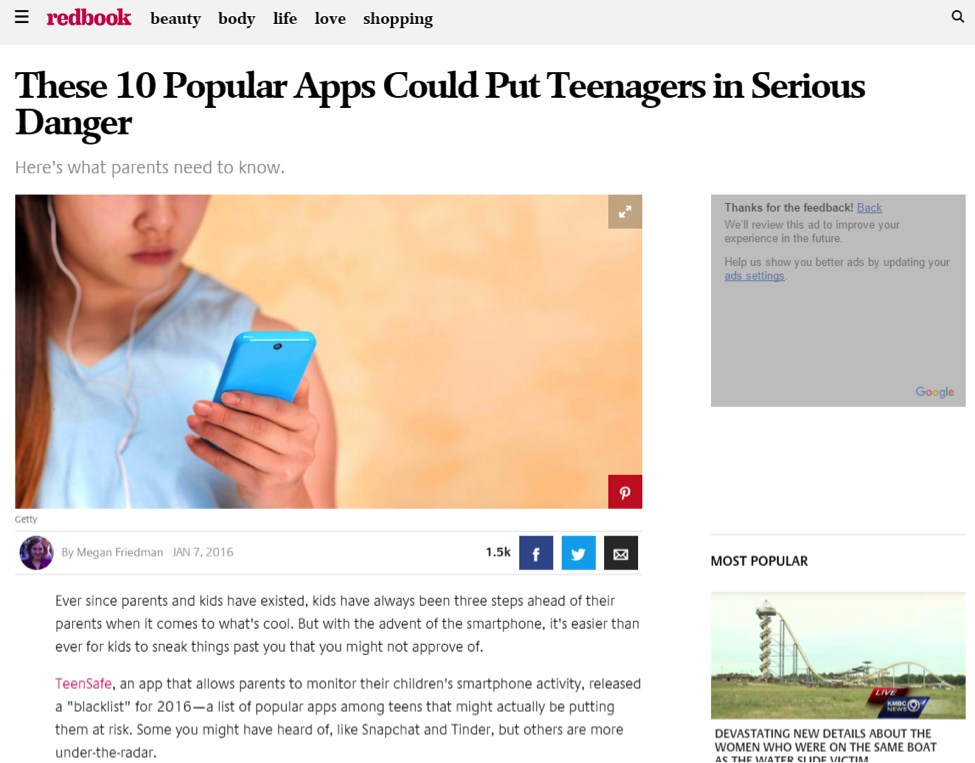
At the ideation stage, both teams worked together to come up with the concept for the infographic. Once the infographic was created, the work done with PR made it possible for the piece to be placed on this, and other media websites, generating powerful links, brand awareness, and traffic.
3. PR & influencer outreach
For PR, it's important to have different content assets to use when pitching different media outlets. Some editors will resonate well with playful infographics, while others may respond to a report announcing the release of new data, while yet others may be happy to share videos.
Targeting each outlet & editor with the most relevant asset is half the battle.
Complement the media outreach with an influencer and blogger outreach campaign. To do so, use the media hits already acquired by PR.
In the example above, you can then use that link to Redbook Mag in the pitch email that you send to bloggers. Name dropping will get your bloggers to notice and want to jump on the bandwagon!
To create your influencer and blogger outreach list, use google search operators to find people who have talked about relevant topics. You can also use a tool like PressRush to help you identify the best editors or influencers to reach out to. Once again, Buzzsumo is also invaluable at this stage.
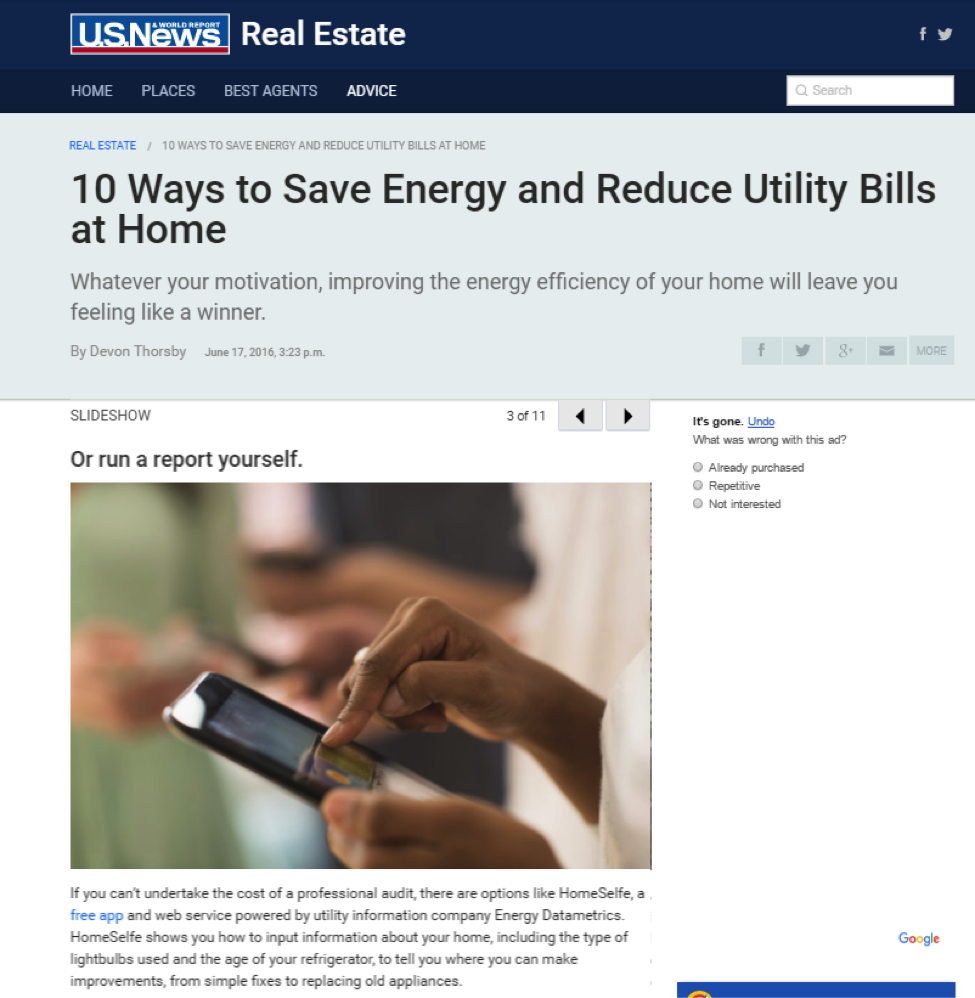
For Homeselfe, an energy efficiency app, we created a report about 10 ways that individuals can save energy and reduce utility bills. US News ran with it, featuring Homeselfe as one of those 10 ways to save money on utility bills.
4. Social Amplification
Every media hit should be used to help you gain others, establish brand credibility, and for social amplification.
Each media hit should be shared on all your social channels multiple times. Of course, you should @mention the media outlet that shared, and use that as an opportunity to deepen the connection with that journalist or influencer.
Write a blog post on your site including a screen grab of the media hit, and share that post on your social channels as well, multiple times. MissingLettr can be used to craft various tweets for each blog post, making sure that media hit is continuously shared with your audience.
Finally, consider creating an Facebook ad campaign with your media hits. One campaign could be targeted at your buyer personas, while another could be targeted at editors of relevant magazines and newspapers.
By placing your media hits in front of other editors, you are planting seeds to let them know that you are newsworthy, and when your PR team reaches out to them with a direct pitch, they'll be more likely to accept.

Above is an example of a post that was advertised to an audience of parents. With less than $250 dollars, we generated 6500 post engagements, each at less than 5 cents.
![]()
Even though the traffic wasn't sent directly to the client's site, this strategy resulted in brand awareness and several members of the other site's audience reaching out to Teensafe.
Getting started
You don't need to have a PR team on board to earn powerful media hits. If you have a strong content marketing campaign in place, start reaching out to the media and sharing your content assets.
Earning media mentions is worth the effort, and with a strategic approach, you'll be sure to earn those coveted placements!
Thursday, August 18, 2016
How UX designers and SEOs can work together
There's been an awkward separation between UX and SEO in previous years, and it's always difficult to move past an 'us and them' mentality. But if your business is going to be on track for success, then both need to be working in harmony.
It is the duty of SEOs to stay perpetually up to date with how Google algorithms work so be sure you listen to their opinions, even if they're talking design issues.
Thankfully, SEO and UX are gradually merging into the same thing, which is good news for everyone.
Visitors receive a better experience, businesses have a guide on how to satisfy their customer needs (assuming they research how the algorithm works) and UX designers and SEOs can finally put their differences aside and work together.
Here are several practical ways in which SEOs and UX designers can achieve this goal…
Website visitor metrics to help UX
Nowadays, the job of SEOs is centred around understanding as much as possible about the website in order to inform the design process.
To gain a thorough understanding, data gathering will involve looking in Google Analytics for typical metrics such as audience demographics, user journeys, popular page content, what users are searching for on your site, how long a user will remain on content, how quickly a website loads and how far a user scrolls down a page.
This data is extremely important for designers as it helps them create a website architecture, layout and depth of content that will help their users navigate easily to content that they're interested in without thinking too hard.
In other words, SEOs discover the kind of experience users want and UX designers implement it.
Analysing Google ranking positions to spot areas for UX improvement
Knowing where pages on your website rank is important, especially during the research phase.
To a designer, an SEO gathering Google rankings won't help their design process because it appears to be more of a marketing activity than a UX one. However, understanding where pages on your website rank/don't rank will make an SEO question the pages on the site and investigate technical issues, content and competitors that are ranking well.

From their analysis, an SEO can make sure designers are supplied with content more fitting to users' expectations. This content can be integrated into the website. SEOs can also report on any technical issues to consider during the user's journey, such as popups and internal linking.
Ongoing reporting and improvements
When a new website (design) is launched, it's the start of the journey, rather than the end of a project. UX designers produce a product based on experience, skill and insight, but, despite their best efforts, the user may experience some pains when using the website.
In order to monitor and interpret potential UX problems, it's vital the website is set up in a manner that allows you to gather real experience data. This insight will drive future website changes to alleviate any pain experienced by the user.
This is where SEOs can help.
In order for Google Analytics to track accurate user behaviour on websites, it's important that goals and events are configured correctly. In addition, setting up advanced segments and filters will help provide in-depth understanding rather than vanity metrics.
Be wary of vanity metrics – they can completely skew an understanding of how well the user is experiencing the website.
Finally, it's also vital to connect the Google Search Console as the data provided can help fix broken links, speed up a website, improve mobile friendliness and provide more engaging metadata, helping the relevance of the content to the end user.
Jamie Schaedel is Technical Director of Dusted and a contributor to SEW. This is an adapted version of his previously published blog post.
Wednesday, August 17, 2016
Marketers have high hopes for automated content
In a poll conducted to accompany the ClickZ Intelligence Digital Trends 2016 report, nearly a quarter of respondents identified content marketing as the key trend for their company this year.
But despite the widespread adoption of content marketing, companies still face numerous challenges in putting it to use effectively. For example, the majority of companies don't have a dedicated content marketing team. Instead, many task their marketing departments with content marketing responsibilities.
Given the difficulties companies face in producing content, it's probably not a surprise that according to a study conducted by Forrester Research on behalf of cognitive content platform provider Persado, a growing number of senior marketers in the US and Europe have high hopes for automated content production.
Three-quarters of those Forrester polled believe that automated content creation will make it easier “to maintain and update content,” a logical expectation.
More than half (56%) expect that automating content creation will give them the ability to produce content that is modular and can be assembled dynamically, while nearly half (47%) see automated content as a means to adjust and respond in real time.
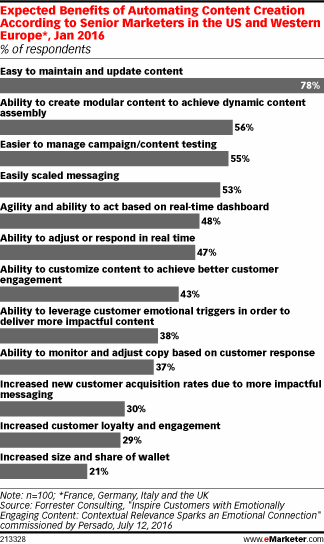
But marketers' expectations don't stop there. Indeed, large percentages of those surveyed believe that automated content creation won't just increase volume and speed, but help them improve the efficacy of their content marketing altogether.
For instance, 43% believe automated content creation will help “customize content to achieve better customer engagement” and 38% think it can help them “leverage customer emotional triggers in order to deliver more impactful content.”
30% and 29% even anticipate that automating content creation will increase new customer acquisition rates and boost customer loyalty, respectively.
Unrealistic expectations?
The problem for marketers is that automated content creation technologies may not be able to deliver on those more ambitious expectations.
Even the co-founder of Persado, the company that commissioned the Forrester study, told TechCrunch, “to get to a place where a machine can turn out an article with (ideally) some creativity and critical analysis will take another 20 years.”
What's more, the biggest problems organizations face in making content marketing work are not about technology, or even content production, as evidenced by the fact that half of content companies produce is never put to use.
Instead, the biggest challenge holding content marketing back is lack of clear strategy and the third biggest is conflicting goals between departments.
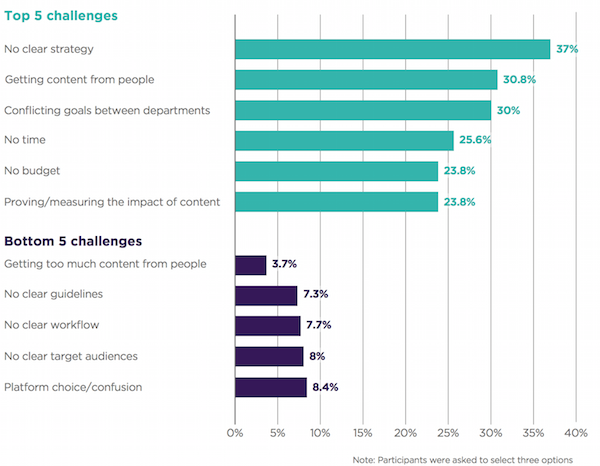
So while automated content production will almost certainly increase as content marketing becomes an even more important part of the digital marketing mix, to take real advantage of these technologies, companies will need to ensure that their content marketing efforts are grown up.
Tuesday, August 16, 2016
Five ways analysts can take their skills to the next level
As I've been writing about tools and tactics quite a bit lately, I thought for this month's column I'd take a step back and share some ideas on how you can become a better analyst.
And improving our analysis skills as marketers goes beyond broadening our career options and helping us be better at our craft.
It should actually improve all areas of your life as a byproduct of nurturing our critical thinking skills. Some ideas follow that I apply in my own life and hope you'll consider too.
Find a passion outside work which involves developing hypotheses
The scientific method, as you know, is a body of techniques for investigating phenomena, acquiring new knowledge, or correcting and integrating previous knowledge.
You're already applying this to your marketing and analytics practice by putting it to work for testing and optimization efforts (for example, having a hypothesis that a new landing page with less clutter will convert better, which you then test).
But beyond work, you should also, in free time, be involved in something which flexes your prediction muscle.
Whether this manifests as fantasy sports, investing in startups or some other activity which involves future predictions (and cool datasets!), this can be a fun and rewarding way to sharpen your mind and will help you see analysis problems in a new light.
Learn to fill in the missing pieces, be comfortable working with imperfect data/information
100% perfect data is really only possible in a controlled lab setting with expensive and fine-tuned equipment. While, of course, we should ensure our analytics implementation is setup correctly to keep our own data as clean as possible, we must also get comfortable working with a “good enough” information.
This is necessary in order to be agile in how we work and keep projects moving forward. A great analyst will work out the way to fill in the missing pieces and make effective projections (while of course providing a rationale/caveats where needed).
You want to get confident enough to make recommendations and create analysis' based off “minimum viable data.”
Have a sandbox project to test new tools
If you are truly serious about improving your skills, doing analyst work in your live business environment isn't enough.
The reason being you can't test and tinker with any new tool without permission or change settings at whim, you likely have compliance and managers to work through.
But a sandbox project such as your own site, app or side business provides a place you can test, tinker and experiment in a no-stress setting.
Bonus: our team at Google recently launched an Analytics Demo Account for this very purpose.
Live and breathe your company and sector metrics (beyond what you're accountable for)
Being a great analyst isn't about just running reports and delivering insights that are your remit.
Rather, the best analysts have their finger on the pulse of the bigger pictures and are deftly able to put their own work into context with the larger organization and sector as a whole.
The analysts I talk to that leave a lasting impression are the ones who can speak articulately about various areas of the business and how they make impact across teams and functions.
Be a part of the industry, network and collaborate with peers
I'm personally a big believer in educating others about digital marketing and since starting my career well over a decade ago I've spent time both at and outside of work helping others learn our craft.
Our industry is tight knit and so being an active participant who helps others is of great benefit (not to mention fulfilling).
For you, whether this takes the form of speaking/attending events (such as ClickZ Live), starting your own local analytics meetup, or even making friends with other analysts near you to talk shop this is a valuable use of time.
Adam Singer will be speaking at ClickZ Live San Francisco in August.
Monday, August 15, 2016
Facebook's Lookalike Audiences for ecommerce: segment before you build
One of the most efficient types of targeting in Facebook (second to retargeting, of course) is lookalike audience targeting.
Lookalike targeting is basically a targeting type that allows you to use first party data (e.g. customer lists, remarketing lists, etc.) as a seed audience to find new users with very similar characteristics, behaviors, and traits.
It's applicable for all business models (B2B, B2C, EDU, etc.), but in this post, we'll lock in on best practices for ecommerce.
When using lookalike targeting, the audience you select as your seed audience is extremely important. Essentially, you want to make sure you are developing audience lists from your best-performing audience.
For example, if you had an option to choose between people who signed up for a free trial of your product or people who actually purchased your product, you should start off with the audience that has actually purchased the product; these are the users driving revenue to your business, and you need to find more users like those.
Okay so now that we know we want to target our customers, are we ready to get started and build lookalike audiences? Nope! Hang tight, especially if you have a large customer base.

Step 1: Create smart segments
If you've got a ton of user data to pull from, use it to segment your base into groups with definable characteristics. This helps you tailor creative, messaging, and bidding with far more precision.
When it comes to ecommerce, there are three fundamentals ways you should look to segment your users:
- Average Order Value (AOV): Say you sell a variety of different products, from high-end/expensive items to affordable accessories. Segmenting out your 1st-party data by AOV allows you to better understand the audiences who can afford to go after your more expensive product vs. those who are looking for a bargain.
- Product Category: If you sell multiple different types of products, you'll want to split out your customers by the product categories they have purchased (e.g. women's handbags, women's apparel, etc.). This allows us to better tailor content when running our ads.
- Lifetime Value (LTV): Segmenting audiences by LTV helps you create audiences of users who will most likely be repeat purchasers/loyal customers vs. those who will tend to just buy a few items for their more immediate Separating the two groups will allow you to bid accordingly as you see performance kick in.
Step 2: Build your lookalikes
So now it's time to build out your lookalike audiences, which range from 1% – 10%. What this means is that the 1% are audiences closest in similarities, traits, and behaviors as your seed audience, and it contains only those users, which restricts scale. The 10% audience is the least similar – but it's also the biggest pool.
The way you'll want to set up your campaign is by building ad sets for each segment. So let's say you chose to segment your first party data by AOV; your setup would look like this:
- Ad set 1: LAL 1% of AOV>300
- Ad set 2: LAL 1% of 300>AOV>100
- Ad set 3: LAL 1% of 100>AOV
Step 3: Customize the experience for each segment
So here is why segmenting out your audiences can be so strong – now we can truly tailor the creative messaging and user experience for each audience.
For example, for the high-AOV audience, we would want to show creative with more expensive products and customize messaging to promote high quality, etc. We would then want to send users to a landing page geared around these more expensive product types.
For the low-AOV audience, we would want creative showcasing more affordable products and would tailor messaging around discounts and deals.
Again, we want to ensure we aren't sending these users to landing pages with expensive products, as they will bounce. So we choose the landing page destinations accordingly.
Lookalike targeting is a great way to make the most of Facebook's thousands of data points on its users and get in front of the right core audience.
However, to truly make it successful for ecommerce, it's critical to craft the right strategy, segment out your first party data smartly, and tailor your messaging, creative, and user experience accordingly.
Friday, August 12, 2016
Five most important search marketing news stories of the week
Welcome to our weekly round-up of all the latest news and research from around the world of search marketing and beyond.
This week we have possible bad news for AMP users and good news for AdWords customers who are tired of its UI.
Facebook begins thwarting ad blockers
As Al Roberts reported this week, Facebook has announced that it's changing its desktop ads to thwart ad blocking software.
For those who wish to complain about the amount of ads on Facebook, Andrew Bosworth, Facebook's Ads & Business Platform VP, had this to say, “Facebook is ad-supported. Ads are a part of the Facebook experience; they're not a tack on.”
So, nyah.
However Bosworth makes clear that Facebook has worked hard to introduce tools to help people control their experience, improve how they decide which ads to show and Facebook has created new ad formats that “complement, rather than detract from, people's experience online.”
Are you using Facebook's many ad controls? Do you even know they exist? Did you know that you can choose not to see those ads for hoodies that AMAZINGLY have your family name written on them!?
55% of searchers don't recognise paid ads in Google SERPS
New research from Varn, that comes off the back of a fresh round of Google SERP changes, suggests that more than half of all searchers still can't distinguish between paid and organic results.
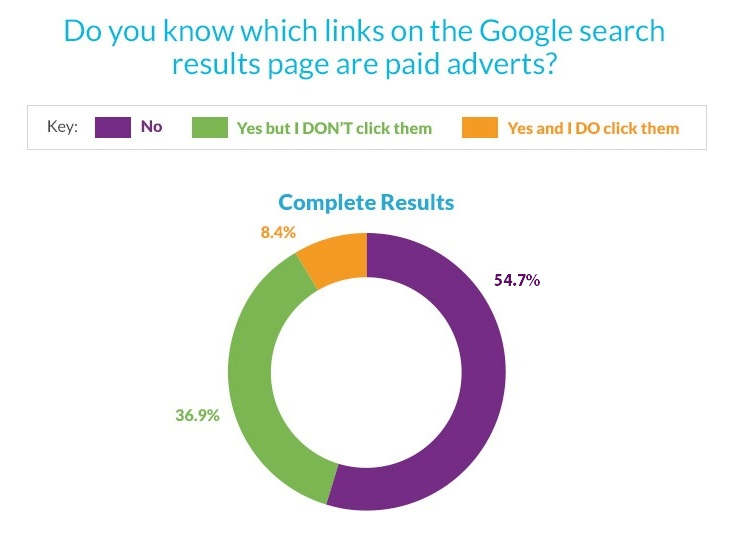
As reported by Graham Charlton this week, the results are also split by age, with the general trend being that the younger you are, the more likely it is that you'll spot the ads. Though almost 50% of 25 to 34s still can't distinguish between paid and organic, despite the paid results being labelled as such.
Google AMP may be leading to lower CTR
Google is rolling out its 'accelerated mobile pages' beyond the Top Stories in mobile SERPs, and this has lead some people to see lower click-through rates on results.
Barry Schwartz from Search Engine Roundtable has seen a lower CTR from AMP pages and Glenn Gabe of G-Squared Interactive speculates that this could be due to the fact that users don't understand what AMP means…
“Looking back the demo and seeing both AMP icons + mobile-friendly tags, I couldn't help but think that the average user might understand mobile-friendly way more than AMP with a lightning bolt. And if that's the case, wouldn't that yield mediocre results for amplified pages in the search results (at least in the short-term)? And couldn't that possibly lead to even more click through to mobile-friendly pages versus amplified pages?”
As Al Roberts reports, Gabe created a quick poll that asked respondents if they knew what AMP referred to. Here are the results:
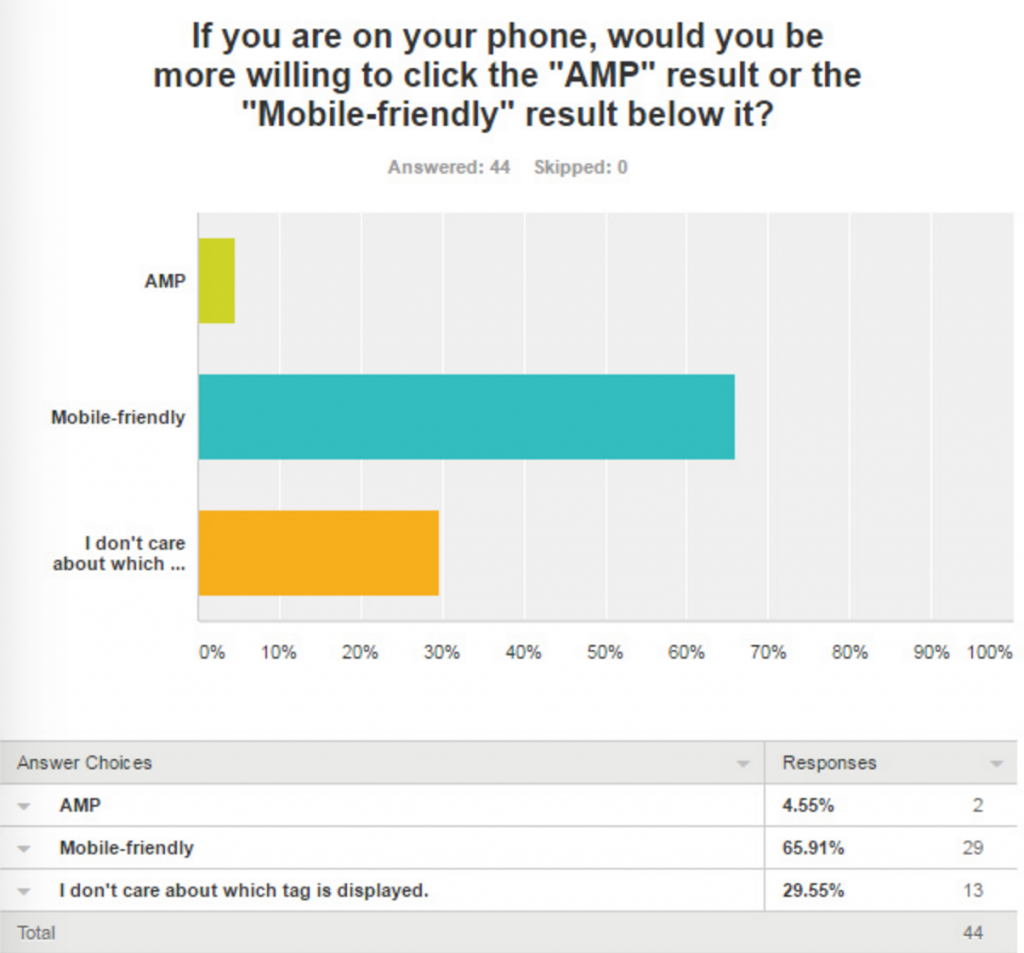
Perhaps Google should've spent more time educating its users, rather than panicking webmasters.
Google Now to deliver more 'personalised' results
As reported by Matt Southern from Search Engine Journal, Google's personal virtual assistant Google NOW is experimenting with a new feature to bring you more content you care about…
“Explore Interests” lets users identify their interests from six different categories: Sports, TV, Movies, Musicians, People, and Stocks. Then you can get more detailed by selecting your favourite sports teams, favorite musicians, etc.
Google will then deliver new content from those interests directly to you in the form of a Google Now card. As Matt says, “Theoretically you can have all the content you're interested in delivered to you without you having to search for it.”
New look Google AdWords is rolling out to users right now
Google has confirmed to Search Engine Land that the new look AdWords is gradually being rolled out to users from this week.
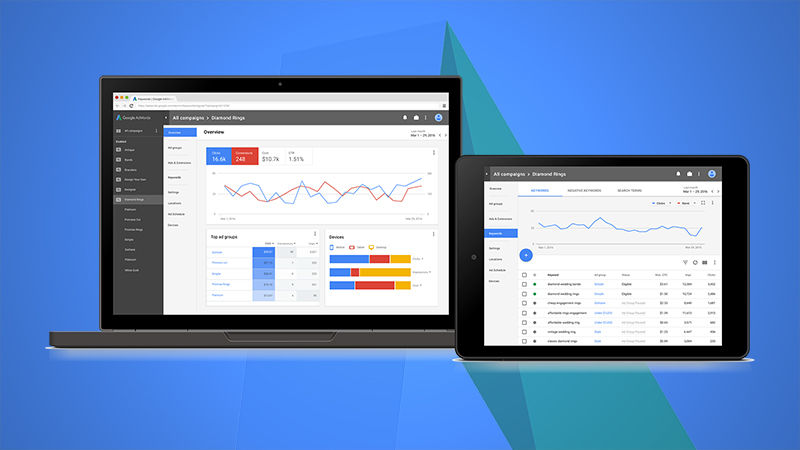
The changes are purely aesthetic, rather than a complete overhaul, but it does bring AdWords – which was beginning to look quite dated – in line with its other, newer products.






